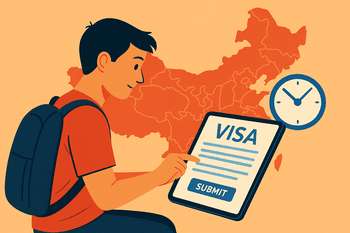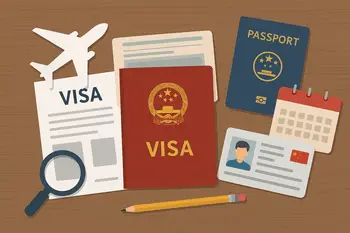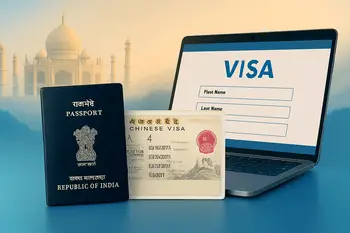
China has just rolled out a major overhaul of its visa application process, moving from a largely paper-based system to a primarily digital workflow.
Travelers around the world now benefit from remote form-filling, document uploads, and a single in-person appointment—dramatically cutting processing times and administrative hurdles.
This transformation marks a milestone in China’s post-pandemic travel recovery and its ambition to lead in digital governance.
From Paper to Digital: A Shift in Perspective
Traditionally, applying for a Chinese visa meant multiple trips to an embassy or visa center, long queues, and manual submission of printed forms and supporting documents.
That process often took weeks from start to finish.
The new online system replaces much of this friction with a user-friendly web portal where applicants can create accounts, complete applications, upload scans of passports and invitation letters, and even track their status in real time.
Key Features of the New Online System
Account Creation and Secure Login
Applicants register using an email address, set up a password, and verify their identity before accessing the visa application dashboard.
Simplified Application Form
The number of required fields has been cut by 34 percent, focusing only on essential data and eliminating redundant questions.
Remote Document Upload
Supporting documents—such as passport scans, photographs, and invitation letters—can now be uploaded in common digital formats, reducing paper waste.
Single In-Person Biometric Appointment
After initial online review, applicants receive a “Visa Application Submission Certificate.”
They print it and visit the visa center one time to submit their passport, provide biometric data, and pay fees.
Real-Time Status Tracking
Users can log back into the portal at any time to see whether their application is “Under Review,” “Passport to Be Submitted,” or “Approved.”
Express Processing Option
For an additional fee, applicants can opt for expedited handling once their materials arrive at the center, with clear timeframes laid out on the portal.
Impact on Travelers
- Travelers now experience significant time savings and greater predictability.
- By handling most steps online, applicants avoid repeated long waits at consulates.
- The one-visit model allows them to schedule appointments around existing travel or work commitments.
- Early adopters report overall processing times falling from 10–14 business days to as few as 5–7 days, depending on local consulate workloads.
Benefits for Administration and Consulates
Consular and visa center staff also gain from the shift:
Reduced Foot Traffic
Fewer in-person visits enable staff to serve more applicants in less physical space.
Streamlined Workflows
Digital intake means forms come into the system pre-checked for completeness, lowering the backlog caused by incomplete paper submissions.
Enhanced Data Security
Biometric collection remains in person, while encrypted data storage reduces risks of document loss or tampering.
Flexible Scaling
Digital systems can be scaled up with minimal physical infrastructure changes, preparing consulates for surges in demand.
Rollout Timeline and Geographic Coverage
- March 31, 2025: Official launch by the Consulate-General of China in Manchester. Applicants in the UK became the first to use the new system.
- June 23, 2025: China Visa Application Centers in major global hubs—such as New York, Paris, and Johannesburg—switched over to the online workflow, marking full deployment at all centers worldwide.
- Future Phases: Plans are underway to integrate e-visa categories and extend automated pre-clearance to frequent business travelers.
Comparing Old and New Processes
| Process Step | Previous System | New Online System |
|---|---|---|
| Application Form | Paper-based, 50+ fields | Digital, 16% fewer fields |
| Document Submission | In-person multiple visits | One-time in-person after online review |
| Biometric Data Collection | At first appointment only | Same, but scheduled via portal |
| Status Updates | Phone or email inquiries | Real-time portal notifications |
| Processing Time | 10–14 business days | 5–7 business days (standard service) |
| Fee Structure | Flat rate | 25% reduction in fees; variable express options |
Practical Tips for Applicants
1. Prepare Digital Scans Early
Ensure your passport scan and photograph meet the portal’s resolution and format requirements to avoid rejection during initial review.
2. Book Your Biometric Appointment Strategically
After receiving your Submission Certificate, choose an off-peak time to minimize waiting at the visa center.
3. Monitor Your Email and Portal Daily
Any supplemental document requests must be addressed promptly to avoid delays.
4. Leverage Express Service if Time-Sensitive
For last-minute business trips or events, the paid express option can shave days off standard timelines.
5. Familiarize Yourself with Fee Waivers
Certain nationalities and visa categories may enjoy reduced or waived fees—review the official policy page before applying.
Conclusion: A Blueprint for Global Digitalization
China’s new online visa system sets a precedent for how large, complex immigration processes can be modernized.
By shifting the bulk of interactions online while preserving necessary in-person security checks, it achieves both efficiency and integrity.
As more countries explore digital visa portals and e-visas, travelers benefit from seamless cross-border mobility and predictable timelines.
Whether you’re planning a business trip to Shanghai or a cultural tour of Beijing’s historic sites, the new online system makes securing your travel documents smoother than ever.


